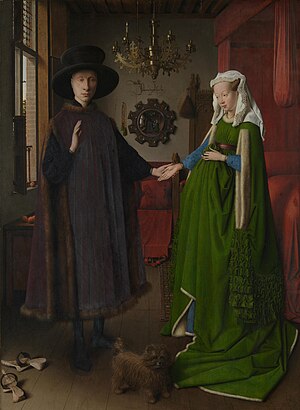All AP Art History Resources
Example Questions
Example Question #116 : Nineteenth Century 2 D Art
Paul Gauguin's later work depicts the culture, people, and environment of __________.
Polynesia
Japan
Persia
Sub-Saharan Africa
Polynesia
Paul Gauguin was an important French post-impressionist who had considerable success and personal conflicts in late nineteenth century Paris. Gauguin took his first trip to Polynesia in the 1880s, and began living there nearly full time by 1890. Gauguin's work featured the women of Polynesia in his work in bright colors and interesting poses, and with odd symbolism.
Example Question #114 : Nineteenth Century 2 D Art
The figure in the painting shown in Figure 2 is presented in a pose that makes him appear __________.
serene
imposing
confident
haughty
serene
The use of the many Japanese images behind the central figure suggest a sense of chaos, but the individual's pose suggests serenity and calm. This is an intentional choice by the artist, Vincent van Gogh, so that his subject, Père Tanguy, can have his serene nature enhanced. The comfortable setting and the relaxed position of the arms also strongly contribute to this sense.
Figure 1: The Starry Night by Vincent van Gogh (1889)
Figure 2: Portrait of Père Tanguy by Vincent van Gogh (1887-8)
Example Question #115 : Nineteenth Century 2 D Art
The painting shown in Figure 2 uses artwork and style from __________.
Persia
Polynesia
Japan
China
Japan
The Japanese government underwent a major shift in 1868 with the "Meiji Restoration," which saw it open up to outside powers for the first time in centuries. In Europe, this sparked an intense interest in Japanese art traditions, particularly among impressionists and post-impressionists. Vincent van Gogh was one of many artists to place Japanese artwork into his own work, as in his Portrait of Père Tanguy from 1887-8.
Figure 1: The Starry Night by Vincent van Gogh (1889)
Figure 2: Portrait of Père Tanguy by Vincent van Gogh (1887-8)
Example Question #114 : Nineteenth Century 2 D Art


Figure 3 Figure 4
The above paintings portray the chief generals of __________.
the Battle of Waterloo
the Battle of Gettysburg
the Battle of Yorktown
the Battle of Agincourt
the Battle of Waterloo
These two paintings portray the most famous generals of early nineteenth century Europe. The painting in Figure 3 portrays Napoleon Bonaparte, as painted by Jacques-Louis David, and the painting in Figure 4 portrays Arthur Wellesley, Duke of Wellington, as painted by Sir Thomas Lawrence. These two men met in battle numerous times, most famously at Waterloo in 1815, in Southern Belgium. There, Wellington's allied forces soundly defeated Napoleon's Grand Army of France, forcing him into a second and more permanent exile.
Figure 3: Napoleon Crossing the Alps by Jaques-Louis David (1801)
Figure 4: Portrait of Sir Arthur Wellesley, First Duke of Wellington by Sir Thomas Lawrence (1814)
Example Question #1 : Answering Other Questions About Nineteenth Century 2 D Art
The type of photographic process which placed the image on a silver plate was the __________.
daguerreotype
camera obscura
tintype
negative
daguerreotype
A daguerreotype was a laborious process, which captured an image on a piece of silver, which then had to be rubbed with various chemicals to make the image appear; nonetheless, the daguerreotype, named after its inventor Louis Daguerre, was the first easily reproduceable photographic process on its creation in 1837. The daguerreotype was supplanted by the 1860s with a variety of quicker methods.
Example Question #1 : Answering Other Questions About Nineteenth Century 2 D Art

Figure 1

Figure 2
The movement represented by these two paintings were a reaction to __________
Romanticist painting.
Medieval painting.
Renaissance painting.
Abstract painting.
Romanticist painting.
Realism, developed and argued for by Gustave Courbet, reacted harshly against Romanticism by attempting to find authenticity and commonality in stark depictions of everyday scenes. In each of these paintings, Courbet portrays himself largely as what he was, a working painter struggling to make a living. In The Desperate Man, Courbet's self-portrait still exhibits some Romantic-era traits, such as energetic strokes and movement. The Meeting, however, is a fully mature Realism, with extremely clean lines depicting a scene of common people rather than monarchs or heroes.
Example Question #311 : 2 D Art

Figure 3

Figure 4
Figure 3 is a painting of __________
the Palace of Versailles.
Hotel des Invalides.
the Pantheon.
Rouen Cathedral.
Rouen Cathedral.
This painting is one of a series of paintings by Claude Monet that is a study of the front of Rouen Cathedral in different light, with this one taking place in direct sunlight. All of the Impressionists were highly interested in the different effects of light, but Monet went farther than his fellow Impressionists. The avant-garde artistic approach, including incomplete and highly visible paint lines, is contrasted with the subject of the painting, a Gothic cathedral in Rouen, Normandy.
Example Question #313 : Ap Art History

Figure 3

Figure 4
To capture the light on the edifice, the painter of Figure 3 __________
used watercolors on top of oil paint.
painted in vivid colors.
drew in bright clear lines.
layered various colors of oil paint.
layered various colors of oil paint.
Monet's goal in painting Rouen Cathedral was to capture the ever-changing aspect of light off the stone of the building. Due to constantly-shifting nature of the light, however, Monet had to use a unique approach, wherein he layered small amounts of different but related colors to create a naturalistic effect of shimmering light. This technique and effect would be used later by Monet in his famous series of Water Lillies from his own garden.
Example Question #4 : Answering Other Questions About Nineteenth Century 2 D Art
In the "hierarchy of genres," which of the following genres was accorded the highest place by artistic authorities in the early eighteenth century?
Portrait painting
Still life painting
History painting
Landscape painting
History painting
The "hierarchy of genres" was the dominant view of the different forms of painting by the academies that controlled art in the seventeenth, eighteenth, and nineteenth centuries, especially in France. Different types of painting were seen as requiring more mastery than others. History painting (which included religious and mythological themes) was above all other genres, as it was believed to require more control over its scope and perspective.
Example Question #5 : Answering Other Questions About Nineteenth Century 2 D Art

Pictured above is the Arnolfini Portrait, and can be found at the Website of National Gallery, London.
The painting was most likely commissioned by __________.
Jan van Eyck
the King of the Netherlands
the local Bishop
Mr. Arnolfini
Mr. Arnolfini
The painting, of the Northern European Renaissance, is of Giovanni Arnolfini and his young wife, and the detail of the characters and their home suggests it was commissioned by the couple, likely the husband, for their wedding.
All AP Art History Resources






